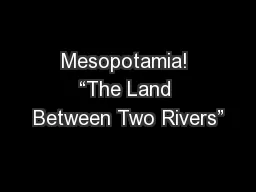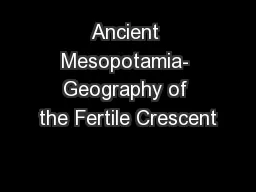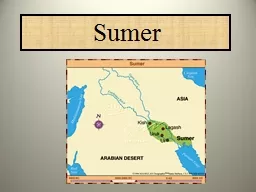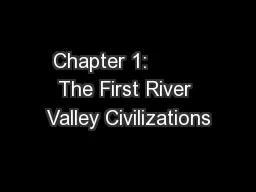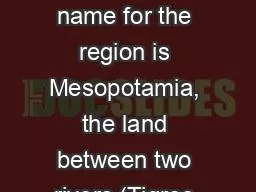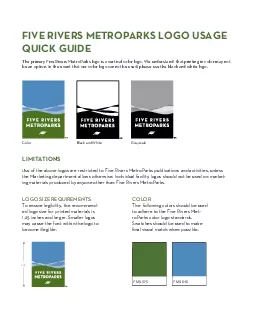PPT-Mesopotamia! “The Land Between Two Rivers”
Author : debby-jeon | Published Date : 2018-03-22
Introduction Civilization developed between the Tigris and Euphrates Rivers By 3000 BC a number of cities are established by the Sumerians Role of Environment Created
Presentation Embed Code
Download Presentation
Download Presentation The PPT/PDF document "Mesopotamia! “The Land Between Two Riv..." is the property of its rightful owner. Permission is granted to download and print the materials on this website for personal, non-commercial use only, and to display it on your personal computer provided you do not modify the materials and that you retain all copyright notices contained in the materials. By downloading content from our website, you accept the terms of this agreement.
Mesopotamia! “The Land Between Two Rivers”: Transcript
Introduction Civilization developed between the Tigris and Euphrates Rivers By 3000 BC a number of cities are established by the Sumerians Role of Environment Created in a region that . Mesopotamia. Humans lived as . nomads for tens of . thousands of years . before slowly . settling down in . various parts of the . world. . Nomads are . people who have no . permanent home and . travel in search of food and safety. . Mesopotamia. “Land between the rivers”. Between the Tigris River and Euphrates River. Fertile Crescent. Little rain. Silt from river. Mesopotamia. Flooding. Snow melt. Irrigation and drainage ditches. th. . Bellwork. Checkpoint #45. Classwork. India map. Test next Friday, 14. th. . Check Point #45. Number 1-7. 30 seconds per slide. 1. What larger region was Mesopotamia located within?. Sahara Desert. Chapter 5 . History of the Fertile Crescent. The Main Idea. The rivers of Southwest Asia supported the growth of civilization. New farming techniques led to the growth of cities. .. The BIG Idea. The valleys of the Tigris and Euphrates rivers were the site of the world’s first civilizations.. Standard 6-1.3 . Let’s Remember… . https://. www.youtube.com/watch?v=CJdT6QcSbQ0. . Ancient River Valley Civilizations. Geography. - where are they located, natural boundaries . Architecture. - what did they build that they are ‘famous for’ . By Mr. Zindma. n. Unit 2. 1. Section 1: Geography and the Fertile Crescent. 2. Essential Question. : How did geography influence the development of civilization in Southwest Asia?. The Big Idea: . . 6. th. . Grade Social Studies. Chapter 5 Lesson 1 in the World Text. The Big Picture. Around 4000 BC Egyptian farming communities were growing along the Nile River.. Another civilization was also developing in . what is now the country of Iraq.. Mesopotamia was part of a larger region called the Fertile Crescent. This area, that stretched from the eastern edge of the Mediterranean Sea down to the Persian Gulf, had fertile soil and was where many civilizations started. The shape is somewhat similar to a crescent (think of a crescent roll, or a crescent-shaped moon).. Mr. Korinek 7. th. Grade Social Studies. The Four Empires of Mesopotamia 2300 and 539 B.C.E. Akkadian. Empire. Babylonian Empire. Assyrian Empire. Neo Babylonian Empire. The . Akkadian. Empire 2300 . Two Early City-States. Catal Huyuk. Jericho. Catal Huyuk is the oldest and the largest Neolithic city found, so far. It dates to 8,000 years BCE and was occupied continuously for 376 generations. No specific reasons for its abandonment have been found. . History of the Fertile Crescent. The Main Idea. The rivers of Southwest Asia supported the growth of civilization. New farming techniques led to the growth of cities. .. The BIG Idea. The valleys of the Tigris and Euphrates rivers were the site of the world’s first civilizations.. Rivers What do you know about rivers? Do you know where rivers come from? Do you know any rivers in your local area? What types of animals would you find in or near a river? Is there anything you would like to know about rivers? Visiting Iraq. The best time to visit Iraq is in the Spring or Winter. Traveling to Iraq in the summer is not recommended because temperatures reach as high as 118.4°F (48° C).. Most Iraqi people speak little English but are exceptionally helpful to foreigners.. PMS 46PMS 75 125148Do nt put a bxaound the lgo INCORRECT31USEIn order to prevent inconsistent use of the Five Rivers MetroParks logo it must always be scaled appropriately The logo must not be stretch
Download Document
Here is the link to download the presentation.
"Mesopotamia! “The Land Between Two Rivers”"The content belongs to its owner. You may download and print it for personal use, without modification, and keep all copyright notices. By downloading, you agree to these terms.
Related Documents

